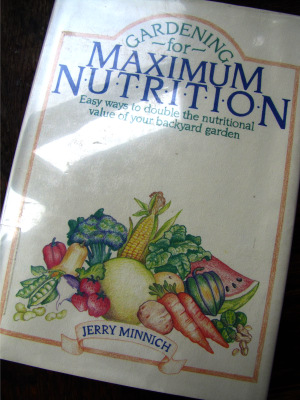
Gardening for Maximum Nutrition
 If
you were looking for a hearty dose of vitamin C in plant form, what
would you eat? If you answered "an orange", you're way off track
--- you'd actually get more of the immune-system-boosting vitamin from
a serving of broccoli, leaf amaranth, sweet peppers, or brussels
sprouts. In Gardening
for Maximum Nutrition, Jerry Minnich exposes
nutritional myths and drops hints for getting the most nutrition out of
your garden.
If
you were looking for a hearty dose of vitamin C in plant form, what
would you eat? If you answered "an orange", you're way off track
--- you'd actually get more of the immune-system-boosting vitamin from
a serving of broccoli, leaf amaranth, sweet peppers, or brussels
sprouts. In Gardening
for Maximum Nutrition, Jerry Minnich exposes
nutritional myths and drops hints for getting the most nutrition out of
your garden.
Minnich notes that
between 1925 and 1971, the American diet saw a 42% decrease in fresh
fruits and vegetables, with the slack taken up by a lot more processed
food. Perhaps
as a result of the focus on processed food, the
nutritional value of those fruits and vegetables declined by 10 to 20%
during the same period. However, processing wasn't the only
reason for the nutritional downturn --- growing methods and vegetable
varieties also led to the watering down of our nutrition.
Gardening
for Maximum Nutrition
was published in 1983, so it has a seventies perspective on
which food groups are bad for you (meats and fats are bad, the potato
is swell.) If you ignore that part, though,
the book is easy to read, full of fun line drawings, and very
informative. And the author boldly states that following the tips
in his book will allow you to double the nutritional output of your
garden without spending any more time or expanding your growing
area. With a claim like that, how could you stop reading?
| This post is part of our Gardening for Maximum Nutrition lunchtime
series.
Read all of the entries: |
Want more in-depth information? Browse through our books.
Or explore more posts by date or by subject.
About us: Anna Hess and Mark Hamilton spent over a decade living self-sufficiently in the mountains of Virginia before moving north to start over from scratch in the foothills of Ohio. They've experimented with permaculture, no-till gardening, trailersteading, home-based microbusinesses and much more, writing about their adventures in both blogs and books.
Want to be notified when new comments are posted on this page? Click on the RSS button after you add a comment to subscribe to the comment feed, or simply check the box beside "email replies to me" while writing your comment.
